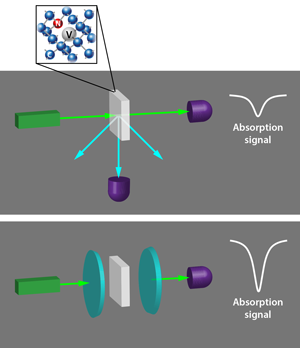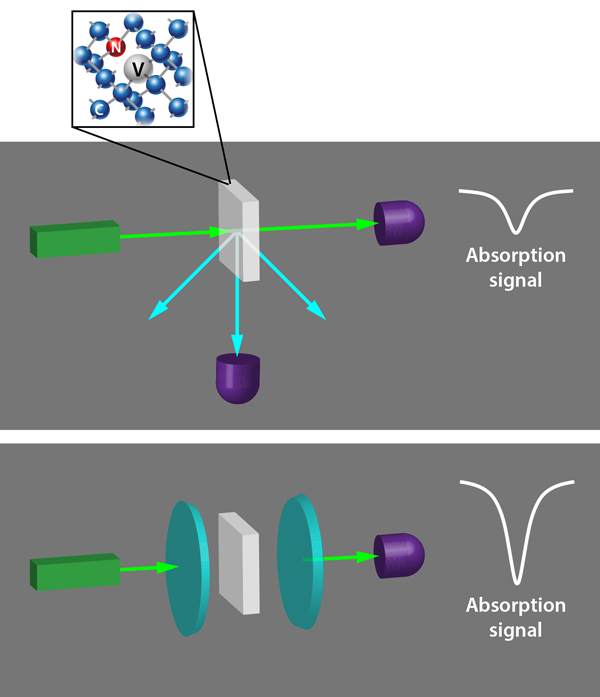Ultrasensitive Diamond Magnetometers
Magnetic field measurements are crucial for many applications, including data storage, information processing, and magnetic resonance. One of the most precise tools for assessing magnetic field strength is detection of the energy shifts of atomic systems having spin. Such measurements can be particularly sensitive when the magnetic response of the spins is measured optically [1]. In a paper in Physical Review Letters, researchers in the group of Dmitry Budker at the University of California, Berkeley, and colleagues report a magnetometer based on the spin state of a diamond defect called a nitrogen-vacancy (NV) center, which exhibits unprecedented sensitivity at room temperature [2]. This opens up possibilities for applications such as high-precision field measurements, novel nuclear magnetic resonance (NMR) sensors, measurements of fundamental physics constants, and detection of fields associated with biological processes like propagation of signals in the brain.
The original idea behind optical detection (proposed many decades ago by Kastler [3]) is to use energy-level transitions that are accessible from the ground state in paramagnetic atoms and are coupled to optical transitions. In this case, optical fields can be used to polarize the sensing atoms (via optical pumping) and for detection (via change in the absorption or fluorescence signal induced by spin resonance). Since very sensitive photon detectors are available, such an optical detection approach provides up to orders of magnitude enhancement of sensitivity (reaching the ultimate limit of single-spin detection) when compared to direct detection of spin states using inductive coils [like in NMR or electron paramagnetic resonance (EPR) for instance].
Recently, the readout of spin transitions associated with NV centers in diamond was proposed for magnetometry applications [3,4]. NV centers consist of a nitrogen atom substituted into the carbon lattice combined with a lattice vacancy. Solid-state magnetometers (like diamond-based devices) are crucial for making field sensors compact. Although several materials allow optical spin readout, diamond has particular advantages. Spins in diamond are very well isolated from lattice phonons and the coherence time of diamond color centers (which is directly related to the sensitivity of magnetometers) is long, even under ambient conditions. Recently developed optical spin readout and coherent control tools have enabled spectacular proofs of principle of magnetometry experiments. Demonstrations include a record spatial resolution in scanning probe magnetometry [5], detection of NMR and EPR signals at the nanoscale [6,7], sensing biomolecules [8], and imaging magnetic bacteria [9].
Although single NV centers are preferable for nanoscale applications needing high spatial resolution, the highest sensitivity can be reached for diamonds comprising many atomic NV centers. But to date, the precision of multi-NV devices is still amenable to significant improvements: Reported measurement accuracies have not reached the fundamental limit imposed by quantum mechanics (the so-called quantum projection noise). This deviation is related to the fact that photons emitted by diamond color centers are often lost and not detected (see Fig. 1). The work by Budker and colleagues shows significant improvement over existing techniques by using absorption measurements to increase the sensitivity of diamond magnetometers. Unlike emission, the absorption signal can be measured with high efficiency. However, the infrared transition that is used for detection of magnetic signals is weak, and achieving high optical density of light-absorbing NV sensors in the diamond crystal was the challenge addressed by the authors.
Budker and co-workers show that placing NV centers in an optical resonator can increase the infrared optical absorption and allow a noise floor of and sensitivity of to be reached. This sensitivity is comparable to the best SQUID sensors, but their diamond device is able to operate at room temperature. The idea behind this spectacular experiment is to let the infrared laser beam interact multiple times with the diamond crystal (Fig. 1). In order to create NV centers in diamond, a nitrogen-containing crystal was irradiated with high-energy electrons. After irradiation, the crystal contains vacancies that migrate towards nitrogen atoms forming NV defects. In order to avoid parasitic reflection of light on the diamond surface, the crystal was coated with an antireflection layer. The diamond crystal doped with NV centers was placed between two spherical mirrors having high reflectivity ( ) at the frequency of infrared transition of color centers. Owing to this multipath technique, the “effective length” of the diamond sample can be increased, leading to enhancement of sensitivity by orders of magnitude. Multipath detection also allows the sensing volume to remain small (which would not be possible in the case of long diamond crystals), which would allow the design of compact devices to achieve high spatial resolution. Finally, apart from obtaining a high-contrast optical signal, the optical cavity also allows the optical power of the laser to be reduced, which is important for future integration of diamond magnetometers into compact magnetic-field-sensing platforms.
The current performance reported by Budker and colleagues is remarkable: It would allow the measurement of a field as small as one millionth of the Earth’s field. But it could be further improved by tuning the properties of the diamond sample and optical resonators. Very high factors for integrated diamond cavities were reported recently [10,11]. Such high-finesse resonators can further increase the interaction between NV centers and optical fields (especially at low temperatures when the optical transition of NV centers becomes narrow). Improvement can also be achieved by increasing the coherence time of NV centers used in magnetometry experiments: If coherence time is long, the spin transition has narrow linewidth. The narrow spectral line can be measured with high accuracy, and this proportionally increases the precision with which the magnetic field can be determined. Ultralong coherence times (of the order of milliseconds, corresponding to kilohertz linewidth) were shown for nuclear-spin-free diamond samples with reduced concentration of carbon isotope [12]. This would allow NV centers of even higher sensitivity and precision.
References
- D. Budker, W. Gawlik, D. F. Kimball, S. M. Rochester, V. V. Yashchuk, and A. Weis, “Resonant Nonlinear Magneto-Optical Effects In Atoms,” Rev. Mod. Phys. 74, 1153 (2002)
- K. Jensen, N. Leefer, A. Jarmola, Y. Dumeige, V. M. Acosta, P. Kehayias, B. Patton, and D. Budker, “Cavity-Enhanced Room-Temperature Magnetometry Using Absorption by Nitrogen-Vacancy Centers in Diamond,” Phys. Rev. Lett. 112, 160802 (2014)
- A. Kastler, “Quelques Suggestions Concernant la Production Optique et la Détection Optique d’une Inégalité de Population des Niveaux de Quantifigation Spatiale des Atomes. Application à l’Expérience de Stern et Gerlach et à la Résonance Magnétique,” J. Phys. Radium 11, 255 (1950)
- J. M. Taylor, P. Cappellaro, L. Childress, L. Jiang, D. Budker, P. R. Hemmer, A. Yacoby, R. Walsworth, and M. D. Lukin, “High-Sensitivity Diamond Magnetometer With Nanoscale Resolution,” Nature Phys. 4, 810 (2008)
- C. L. Degen, “Scanning Magnetic Field Microscope with a Diamond Single-Spin Sensor,” Appl. Phys. Lett. 92, 243111 (2008)
- T. Staudacher, F. Shi, S. Pezzagna, J. Meijer, J. Du, C. A. Meriles, F. Reinhard, and J. Wrachtrup, “Nuclear Magnetic Resonance Spectroscopy on a (5-Nanometer)(3) Sample Volume,” Science 339, 561 (2013)
- M. S. Grinolds, S. Hong, P. Maletinsky, L. Luan, M. D. Lukin, R. L. Walsworth, and A. Yacoby, “Nanoscale Magnetic Imaging of a Single Electron Spin Under Ambient Conditions,” Nature Phys. 9, 215 (2013)
- A. Ermakova et al., “Detection of a Few Metallo-Protein Molecules Using Color Centers in Nanodiamonds,” Nano Lett. 13, 3305 (2013)
- D. Le Sage, K. Arai, D. R. Glenn, S. J. DeVience, L. M. Pham, L Rahn-Lee, M. D. Lukin, A. Yacoby, A. Komeili, and R. L. Walsworth, “Optical magnetic imaging of living cells,” Nature 496, 486 (2013)
- J. Riedrich-Moller et al., “One- and Two-Dimensional Photonic Crystal Microcavities in Single Crystal Diamond,” Nature Nanotech. 7, 69 (2012)
- V. S. Ilchenko, A. M. Bennett, P. Santini, A. A. Savchenkov, A. B. Matsko, and L. Maleki, “Whispering Gallery Mode Diamond Resonator,” Opt. Lett. 38, 4320 (2013)
- G. Balasubramanian et al., “Ultralong Spin Coherence Time in Isotopically Engineered Diamond,” Nature Mater. 8, 383 (2009)





